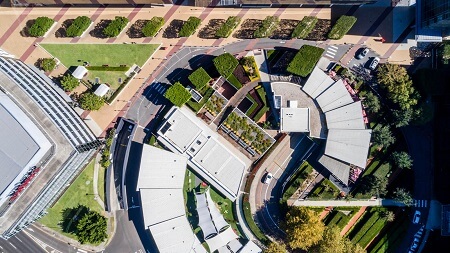Living in 2124: Aussie home predictions for the next 100 years
What is Aussie home life set to look like a century from now? Will we be living in sky-high apartments, in a science-fiction landscape of hoverboards and holograms?
How will home buyers browse and enter the market?
Will suburbia remain the main home of the Great Australian Dream?
Ashley Fell, social researcher at research group McCrindle, says suburban living has proved to be resilient across generations and tumultuous times, so the suburbs will survive but changing dynamics will affect how they look.
“Pressing issues such as population growth, urbanisation, and environmental sustainability are poised to exert significant pressure on housing systems,” Fell says.
“I foresee future suburbs prioritising walkability, green spaces, and mixed-use developments, seeking to foster vibrant communities while addressing challenges such as climate change and urbanisation pressures.”
Here are some expert insights and predictions about the future of housing in 100 years, from design and tech to shopping for property.
Architecture and design
According to Fell, we can expect homes of 2124 to be shaped by technological innovation, sustainability and evolving lifestyle preferences.
“It’s very likely homes of the future will feature seamlessly integrated smart technologies, renewable energy systems, and adaptable living spaces catering to the needs of diverse family structures,” she says.
“Architectural designs may blend functionality with aesthetic appeal, reflecting an ethos of eco-consciousness and community connectivity.”
Brickfields Managing Director David Grant says our notions of longevity will change as climate change either worsens or we learn to live more symbiotically with nature.
“As a result, homes will become more modular, flexible, demountable, even biodegradable,” Grant says.
“Rather than being the ‘forever home’ that was built to last, they will become the ‘for now’ home, utilising innovative natural materials.”
He points to a present-day example, the UK’s mycelium bio-composite blocks by PLP Labs, which is a biodegradable alternative to concrete and steel developed from the root structures of fungi.
Flexible features
Hallum Jennings, Design Director at Frasers Property Australia, says he visualises homes in 2124 to be constructed from a collection of ‘room parts’, with key utility rooms wholly manufactured off-site in a factory.
“This will influence design, as designers will be assembling homes from a catalogue of parts,” Jennings explains.
“External walls will be assembled from smart glazed wall panels that can be transparent or solid, being controlled by the home management system to control the internal thermal environment.”
He believes appliances will continue to evolve as they have over the last 40 years, such as microwaves and dishwashers becoming standard fixtures.
“3D food printers will be commonplace, taking over the role of ovens and cooktops,” he says.
Jennings also predicts the need for onsite vehicle parking will become a thing of the past, with car share and public transport as the primary means of transportation.
What will home buyers want in 2124
In a century, Fell expects prospective home buyers will be seeking features that reflect changing social values and tech advancements in both home design and neighbourhoods.
“Beyond traditional considerations of location and size, eco-friendly amenities such as energy-efficient designs, smart home automation, and sustainable materials could top the list,” she says.
“Adaptable living spaces catering to remote work trends, wellness-focused environments, and connectivity to green infrastructure may become increasingly sought after.”
Grant says access to nature will be an increasingly coveted feature in the future home and could even include holograms to cultivate a sense of green space.
“Nature in the home will serve both experiential and utilitarian purposes. Regarding the experiential, the presence of nature – real or holographic – will support wellbeing,” she says.
“A high-tech example has seen IKEA speculating about the development of bio-solar wallpaper which integrates algae to generate electricity.”
He adds that societies may also rely on nature in the home as a necessity for self-sufficient energy production by 2124.
The housing market in 100 years
In a century, how we view housing and family – and how society meets those needs – will likely shift.
Grant says home buyers will always desire financial freedom and flexibility, and he expects more fluidity around home ownership in the future – “potentially with a transition to membership models or micro-ownership models akin to Exchange Traded Funds on the stock market.”
He adds that we are likely to see continued shifts in traditional nuclear families and a rise in single-parent and co-family households, and life-stage-based living.
“As a result, there will be more nuance in the spectrum of private, semi-private and public spaces on offer,” he says.
“Hopefully in the future this will be experienced by the mainstream through fundamental changes to home ownership.”
Fell says housing affordability, equitable access to shelter, and resilient urban planning will require “innovative solutions and collaborative efforts across public and private sectors”.
“Furthermore, mitigating the impacts of climate change, fostering inclusive communities, and reconciling cultural shifts with housing needs are among the multifaceted challenges that demand proactive strategies for a sustainable future.”
Originally published as ‘Living in 2124: Aussie home predictions for the next 100 years’.
See more articles on
















